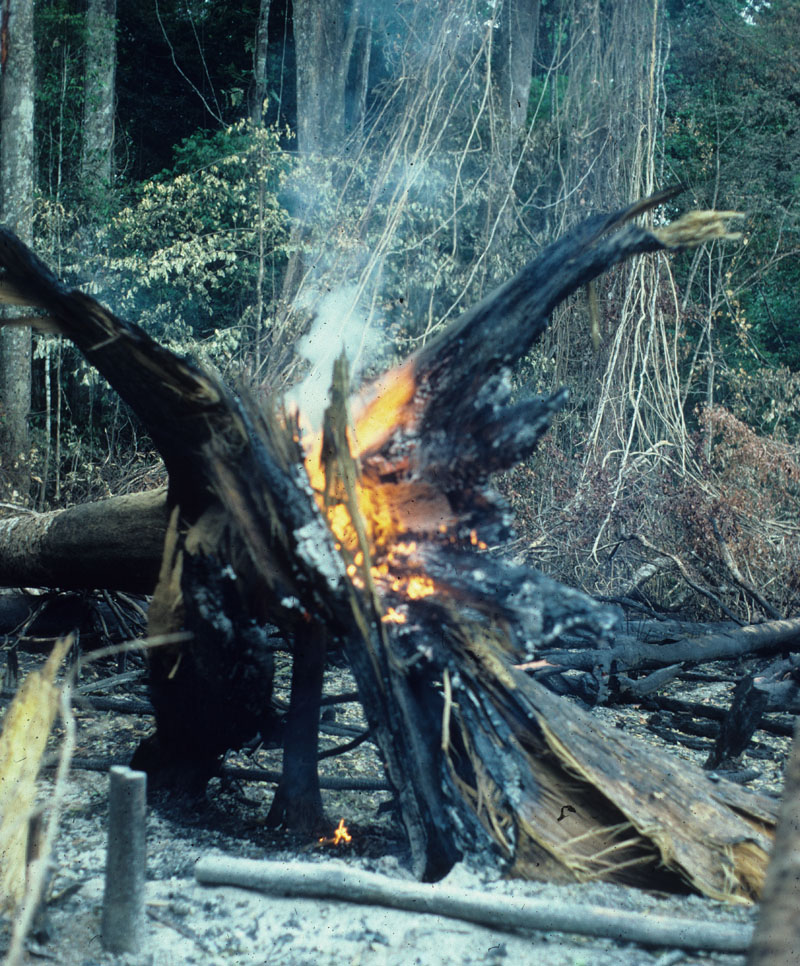How Climate Change Impacts the Extent of Tropical Rain Forests
Posted in Science on January 5 2011, by Plant Talk
 |
Scott A. Mori, Ph.D., Nathaniel Lord Britton Curator of Botany, has been studying New World rain forests for The New York Botanical Garden for over 35 years. He has witnessed an unrelenting reduction in their extent and, as a result, is concerned about their survival. |

Deforestation followed by fires for creating agricultural fields and pasture releases carbon dioxide into the atmosphere at such an accelerated rate in the tropics that it is a major contributor to global warming. Photo by Scott Mori
There are many different types of vegetation in the New World tropics. But rather than being a homogeneous whole, what grows where and when in these tropics is determined to a large extent by water availability and temperature variation. Climate change could potentially have a drastic impact on this region, especially on the rain forests. Liebig’s Law of the Minimum states that plant or animal growth is controlled by the scarcest resource in the environment; this is known as a limiting factor. For example, if a soil possesses all nutrients needed for plant growth except potassium, then the paucity of that nutrient will limit the potential growth of all plants except those that can grow in potassium-poor soils. Potassium is therefore a limiting factor for that soil.
I will use Amazonia to illustrate how Liebig’s Law of the Minimum and climate change could impact the future of New World rain forests.
One of the most important limiting factors for plant growth is water; rain forest plants need more water than savanna plants (and therefore cannot grow on savannas) and savanna plants need more water than desert plants (and therefore cannot naturally be grown in deserts). But it is not just total annual rainfall that determines where a plant will grow; water seasonality is also a critical factor in any given rainfall regime. The time of year when the least amount of water is available acts as a limiting factor for vegetation in that given area–two areas with 1,500 millimeters of rain a year can have completely different vegetation types depending on the seasonality of the rainfall. For example, in the Amazon, an area may be covered by either rain forest or savanna, depending on whether precipitation is distributed evenly throughout the year (rain forest) or is interrupted by a period of low rainfall (savanna). In the latter case, rainfall is a limiting factor in the growth of rain forest trees.
Fires caused by logging and slash-and-burn agricultural practices combined with a dryer climate are causing the loss of vast areas of old growth Amazonian forest and the growth of secondary forests or savannas in its place. Moreover, as forest is replaced by secondary forests or savanna there will be even less moisture available to support rain forest growth. Up to 75% of the rainfall generated in the Amazon is the result of transpiration of water from the trees into the atmosphere. These changes lead to local extinction, and even total extinction of many dominant tree species now restricted to old growth rain forest throughout the New World tropics.
The cutting of forests and the burning of fossil fuels release excessive amounts of carbon dioxide into the atmosphere. These human activities contribute even further to the loss of rainforests and exaggerate changes in rainfall stability. In 2009, part of the year was as dry as it ever has been in the Amazon, and another part was so wet that river water levels were among the highest ever recorded. Both events caused economic hardships for those living in the Amazon Basin, the first made it difficult to grow crops, and the second flooded people out of their homes.
Some argue that climate in the Amazon has always fluctuated between dry and wet periods. While this may be true, the difference between what has happened in the past and what is happening now is that today’s changes are occurring over a shorter period of time and are being caused by people. There have been 125,000 generations (a generation is equal to about 25 years in the United States) of humans since our appearance on earth; but most of the damage we have caused has taken place since the start of the Industrial Revolution, and that is less than 10 generations ago! This demonstrates how rapidly man’s destruction of nature can happen and makes me wonder if the stress on the world’s ecosystems will destroy them and make life on earth much more difficult than it is today.
Humans have had very little to do with the evolution of rain forests, yet they are largely responsible for forest destruction. As Thomas Friedman, in his book Hot, Flat, and Crowded, stated “We are the only species in this vast web of life that no animal or plant in nature depends on for its survival—–yet we depend on this whole web of life for our survival.”


Forest destruction happens also in my country. So sad ;-(